He or she may feel overwhelmed when starting a Deep Water Culture (DWC) hydroponic system, but they can create a thriving garden without breaking the bank. This budget-friendly starter kit will help gardeners acquire imperative gear for under $100, ensuring they have everything needed for successful plant growth. From containers to air pumps, this guide highlights the must-have items that will maximize their yield while maintaining a cost-effective approach to hydroponics.
Key Takeaways:
- A basic DWC starter kit can be assembled for under $100, making it accessible for beginners.
- Essential items include a reservoir, an air pump, air stones, and appropriate tubing to ensure successful hydroponic growth.
- Investing in quality net pots and growing media can enhance the root development of plants in a DWC setup.
- Adding a pH testing kit is important for monitoring and maintaining optimal nutrient levels in the water.
- Lighting is key for plant growth; consider budget-friendly LED grow lights that are energy-efficient and effective.
The Must-Have Components of DWC Systems
Essential Reservoirs: The Heart of Your System
Each deep water culture (DWC) setup relies on a reservoir that holds the nutrient-rich solution necessary for plant growth. Typically, a plastic container or bucket with a capacity of 5 to 10 gallons suffices for small-scale operations; this allows for ample nutrient solution while also being manageable for beginners. He or she may opt for a container with wide dimensions, which can facilitate better root development by allowing roots to expand freely in the solution. Additionally, opaque containers can prevent light penetration, thus inhibiting the growth of unwanted algae in the nutrient solution.
Installation of a sturdy lid is vital to seal the container. This allows for easy installation of net pots or baskets that hold the plants while supporting the structural integrity. Beginner-friendly reservoirs can often be purchased at home improvement or hydroponic supply stores, usually for around $20 or less, confirming that affordability doesn’t have to compromise the quality needed for healthy plant growth.
Choosing the Right Air Pump for Optimal Oxygenation
The air pump serves as a key component in promoting healthy root respiration within a DWC system. Proper oxygenation is vital, as roots submerged in nutrient solution require oxygen to thrive. A good quality air pump should deliver a minimum of 1 liter of air per minute for every gallon of water in the reservoir. Experimenting with pumps that produce a slightly higher output can further enhance root growth, ensuring plants receive sufficient airflow. For a $20 to $40 investment, one can find reliable options that will effortlessly keep plants thriving with continuous oxygen flow.
Some air pumps also come with adjustable airflow capabilities and multiple outlet connections, making it possible to customize oxygen delivery based on individual plant needs. For instance, a pump with four outlets supplies air to multiple containers, making it a versatile option for growers who may wish to expand their DWC systems.
Nutrient Solutions: Finding Affordable Quality
Successful deep water culture systems require a balanced nutrient solution tailored to the specific growth stages of the plants. Finding affordable yet effective nutrient solutions is entirely feasible, as a plethora of brands offers concentrated blends for as low as $15 for a quart. It’s advisable for growers to seek out nutrient concentrates designed specifically for hydroponics. These formulations provide an optimal mix of important minerals and macro- and micronutrients that plants require, without compromising on quality.
Particularly, many manufacturers offer starter kits that include both vegetative and flowering nutrient solutions, giving beginners a comprehensive toolkit to start their journey. Some growers also explore DIY alternatives by using common fertilizers mixed in specific ratios, which can be both cost-effective and tailored to meet individual plant requirements.
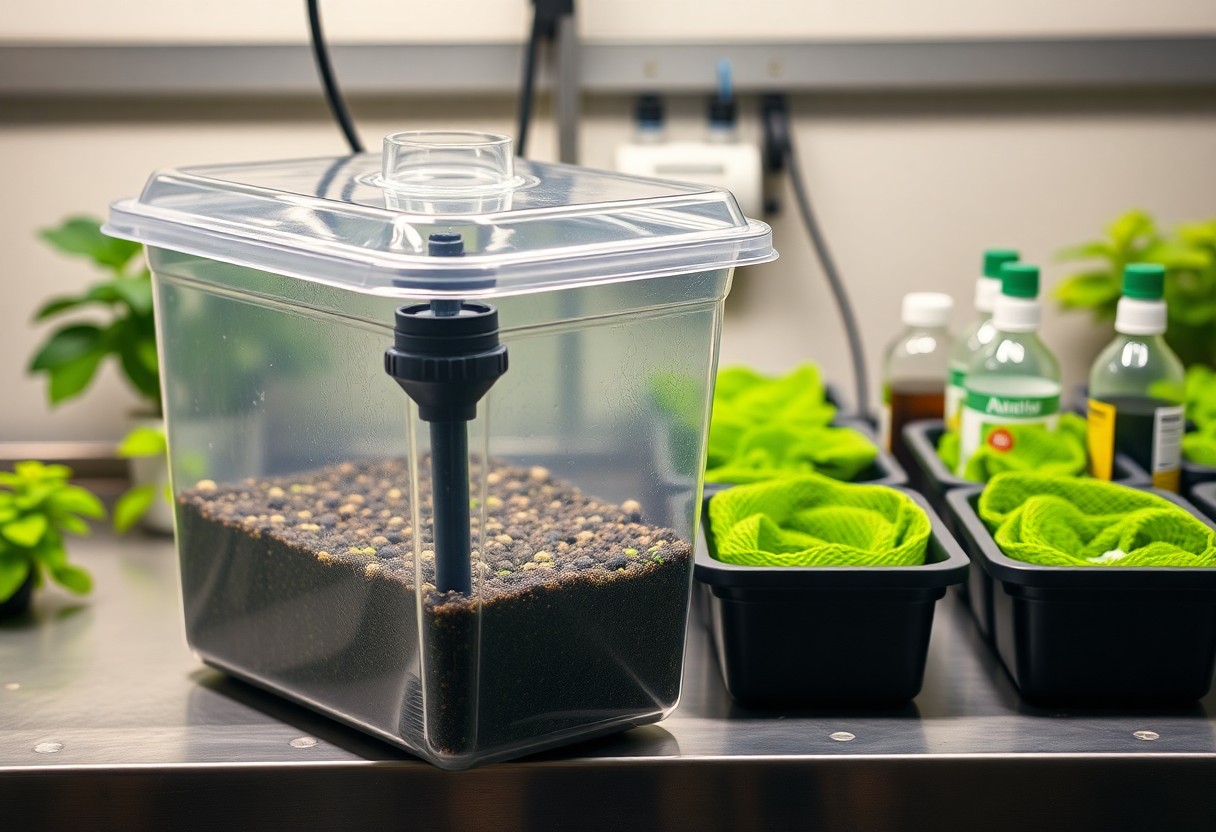
Budget-Friendly Grow Mediums That Work
Rockwool Cubes: Affordable Versatility
Rockwool cubes are a popular choice among hydroponic growers due to their affordable price point and impressive versatility. They offer excellent aeration and moisture retention, which are vital for healthy root development. These cubes are made from spun basalt rock, providing a sterile growing medium that minimizes the risk of pests and diseases. A pack of 50 rockwool cubes typically costs around $20, making them a budget-friendly option for beginners looking to maximize their yield without breaking the bank.
Additionally, rockwool is highly adaptable. They work well in both deep water culture systems and other hydroponic setups, allowing growers to transition between methods as they gain experience. The ease of use and consistent performance make rockwool cubes an invaluable addition to any starter kit.
Expanded Clay Pebbles: A Cost-Effective Option
Expanded clay pebbles are another excellent low-cost choice for hydroponic growers. These lightweight, porous balls provide excellent drainage and aeration while maintaining adequate moisture levels. A bag of 50 liters typically retails for around $15 to $25, making expanded clay pebbles an economical solution for those on a budget. Their structure not only supports root systems but also encourages beneficial microbial activity, which can enhance plant growth.
The durability of expanded clay pebbles is another asset; they can be reused for multiple growing cycles with proper cleaning, further extending their value. They are also less prone to breakage compared to other mediums, making them resilient during handling and watering.
Reusable Alternatives: Balancing Price and Longevity
Choosing reusable grow mediums can significantly offset ongoing costs for hydroponic beginners. Coconut coir, for instance, serves as an excellent option that retains moisture while ensuring adequate aeration. Though the initial investment might be slightly higher—averaging around $30 for a compressed block—coconut coir can be reused for multiple harvests. With proper maintenance, growers can enjoy enhanced performance from this medium while reducing waste and overall expenses.
Another reusable alternative is fabric pots filled with soil or peat-based mixtures, which can be used several times. By focusing on reusable options, growers can achieve a balance between cost and efficiency over time, enabling them to reinvest savings into their gardening ventures.
Lighting Essentials on a Budget
Understanding LED Grow Lights: Cost vs. Performance
LED grow lights have emerged as a go-to option for many hydroponic gardeners due to their impressive energy efficiency and extended lifespan compared to traditional lighting methods. While the initial investment may be higher—generally ranging from $50 to $100 for decent quality—users often see reduced electricity bills and less frequent replacements. High-performance LED models can effectively cover growing areas without generating excessive heat, making them ideal for maintaining optimal conditions in a Deep Water Culture (DWC) system.
With varying spectrum outputs designed to boost photosynthesis, LED lights cater to different growth stages, allowing users to fine-tune their lighting for seedlings or mature plants. This flexibility makes it possible for hydroponic gardeners to maximize growth potential on a limited budget. By comparing various LED products, he or she can find a balance between affordability and necessary features to suit their specific gardening goals.
Fluorescent Light Bulbs: Budget Alternatives for Beginners
Fluorescent light bulbs, particularly compact fluorescent lights (CFLs) or T5 tubes, provide an affordable lighting solution for novice DWC enthusiasts. Prices typically hover around $25 to $50 for a complete setup, positioning them as a viable entry point for those hesitant to invest heavily upfront. Though they lack the intensity of LEDs, fluorescent lights can still effectively promote seedling growth and initial vegetative development.
Unlike their LED counterparts, fluorescent bulbs emit less heat, which allows users to place them closer to plants without risk of scorching. This proximity enhances light availability, encouraging growth even in small spaces. Their moderate energy consumption means that he or she can often run several bulbs at a time without substantially increasing their electricity bills.
Light Schedules: Maximizing Growth with Minimal Investment
Maximizing light exposure through carefully planned schedules can significantly influence plant growth in DWC systems without additional financial burden. Most plants benefit from a cycle of around 18 hours of light during the vegetative stage, followed by around 12 hours during flowering. Routine monitoring of plant response allows for fine-tuning, which can ultimately boost yields.
Timing light exposure also extends beyond the mere build-up of hours; it focuses on optimizing energy use. Setting timers for an affordable continuous cycle ensures consistent growth while minimizing waste, whether utilizing LED or fluorescent bulbs. Adjusting the light duration according to plant stages not only reflects a budget-conscious approach but also encourages strong, healthy development.
Overall, effective planning around lighting schedules enables hydroponic growers to maximize growth potential without breaking the bank. By coupling affordable light sources with structured exposure times, they achieve results typically associated with larger investments.Essential Tools for Monitoring and Maintenance
pH Meters: Accuracy at an Affordable Price
A reliable pH meter is an indispensable tool for those engaging in deep water culture (DWC) systems. Achieving the correct pH balance is imperative for optimal nutrient absorption, and fluctuations can lead to nutrient lockout. For under $40, growers can find pH meters that offer a good blend of performance and affordability. Many budget-friendly models come with a calibration solution, ensuring that readings remain accurate throughout the growing cycle. Regular calibration, typically every few weeks, will help maintain the integrity of measurements, assisting growers in making informed adjustments to nutrient solutions. In practice, maintaining the pH level between 5.5 and 6.5 promotes healthy root development and plant growth. A few dollars spent on a quality pH meter can save significant time and resources in the long run, making it a worthy investment for any hobbyist or beginner.TDS/EC Meters: Essential for Nutrient Management
TDS (Total Dissolved Solids) and EC (Electrical Conductivity) meters are vital tools in ensuring that nutrient levels remain balanced in a DWC system. These meters measure the concentration of dissolved nutrients in the solution, allowing growers to monitor how much water and nutrient mix is delivered to the plants. Priced generally between $20 and $50, these meters provide important readings that help in fine-tuning nutrient solutions and addressing any deficiencies or toxicities early on. In the context of DWC, a TDS/EC meter helps eliminate guesswork. For instance, a typical target for TDS during the vegetative stage might hover around 600-800 ppm (parts per million), while during the flowering phase, one may want to increase that concentration up to 1200-1800 ppm. These measurements guide growers in adjusting feed schedules and solutions, ensuring plants receive the optimal nutrition to thrive.Thermometers and Hygrometers: Keeping Your Environment in Check
Maintaining the right temperature and humidity levels in a DWC setup is important for promoting optimal plant growth and preventing issues like mold or root rot. A quality thermometer and hygrometer combination can typically be found for less than $30. These devices allow growers to monitor the environmental conditions within their growing area, ensuring they remain within ideal parameters—around 68-77°F (20-25°C) for temperature and 40-60% for humidity. Installing a thermometer and hygrometer can significantly contribute to the overall success of a DWC system. By keeping an eye on these metrics, greenhouse or indoor growers can adjust settings promptly, whether it’s by altering ventilation systems or using dehumidifiers to combat excess moisture. This proactive approach not only supports plant health but also improves the likelihood of a successful yield. All things considered, staying informed about the environmental conditions and nutrient levels is as crucial as having the right lighting and components in place. With these monitoring tools, growers can address potential issues swiftly, optimizing their deep water culture experience on a budget.
Practical Solutions for Securing Your Setup
Budget-Friendly Grow Tent Options: Creating the Right Environment
The right environment is vital for any DWC (Deep Water Culture) setup, and opting for a grow tent is a smart choice that can be achieved without overspending. Affordable grow tents can be found for as little as $50, providing a controlled space that reflects light and maintains temperature and humidity. These tents typically come with reflective interiors, which maximize light efficiency, and vents to help with ventilation. By creating a dedicated area, he or she can ensure an optimal growing environment that remains discreet and minimizes disruptions from external factors.
Selecting a tent size that matches existing or anticipated needs is imperative. A 2′ x 2′ tent can cultivate a few plants, while a larger 4′ x 4′ tent can accommodate more. He or she should also consider options with adjustable vents and additional reflective properties to tailor the internal conditions as the plants grow from seedlings to maturity.
DIY Techniques for Ventilation and Airflow
Establishing adequate ventilation is a pivotal aspect of any hydroponic system, as it helps maintain optimal temperatures and air quality within the grow space. Many growers resort to DIY solutions to create efficient airflow without breaking the bank. Utilizing simple box fans or exhaust fans can significantly enhance air movement, and setting these up on timers can adjust airflow patterns according to the plants’ needs. Placing fans strategically to minimize hotspots is also advisable for creating a more consistent temperature across the tent.
A cost-effective method for enhancing airflow involves installing passive intake ports in the grow tent, allowing fresh air to enter effortlessly. By simply cutting holes on the lower side of the tent and covering them with mesh, he or she can ensure pest protection while maintaining good airflow. This method not only costs almost nothing but ensures the plants receive ample CO2 for growth.
In addition to basic fans and intake ports, some growers opt to create a more sophisticated airflow system using plastic ducting, which can be sourced cheaply. These systems can guide air efficiently throughout the tent, ensuring that stale air is expelled effectively and proper circulation is maintained.
Portable Propagation and Cloning Stations: Keeping Costs Low
A portable propagation and cloning station can be a game changer, particularly for those who wish to create multiple plants without incurring high costs. Many DIY enthusiasts turn to plastic storage containers or unused storage bins, transforming these into miniature greenhouses by fitting them with simple humidity domes crafted from plastic wrap or clear lids. This setup encourages a warm, moist environment, which is crucial for rooting clones at an economical price point.
Another innovative yet budget-friendly solution involves using recycled materials—such as leftover cups or trays—to hold seedlings or cuttings. These containers can be filled with a nurturing medium, such as coco coir or starter plugs, allowing the gardener to maximize functionality while keeping expenditures down. Creating a small propagation station can enhance the chances of successful clones while keeping the budget lean.
Investing in small heat mats, often available for $20 or less, is another excellent means to improve germination rates for seeds or rooted cuttings within a portable setup. When combined with environmental control, these stations offer both efficiency and savings.
Affordable Pest Management Strategies
Natural Insecticides: Budget-Conscious Options
Many natural insecticides provide effective pest control without requiring a significant investment. Products containing neem oil, for example, are both affordable and versatile, working against a variety of pests such as aphids, spider mites, and whiteflies. Priced around $10 for a bottle, they can be mixed with water for a powerful spray that keeps invasive species at bay. Additionally, insecticidal soaps, made from natural plant oils and fats, are another great option at similar price points. These soaps suffocate pests on contact and are safe to use on vegetables and herbs, making them a go-to solution for budget-conscious growers.
For those looking to examine deeper into natural options, diatomaceous earth stands out as a reliable choice. This powder, derived from fossilized algae, can effectively manage crawling insects. Sprinkling diatomaceous earth around the base of plants provides a barrier, deterring pests without the use of harmful chemicals. At prices typically under $20, these natural insecticides allow growers to maintain a healthy, pest-free environment without breaking the bank.
Preventative Measures: Maintenance Without Breaking the Bank
Effective pest management begins long before any actual pest problem arises. Regular monitoring of plants is imperative; conducting weekly inspections allows for the early identification of any pests or diseases. Simple methods such as rotating crops and maintaining cleanliness around the growing area can drastically reduce the risk of infestations. For instance, cleaning up fallen leaves and debris minimizes hiding spots for pests and can discourage them from taking up residence in the first place. Implementing these practices does not require any significant financial investment, yet they yield big results in maintaining a healthy grow environment.
His commitment to creating a productive growing area can also include adopting companion planting strategies, where certain plants are grown together to naturally repel pests. For instance, marigolds are known to deter nematodes and other detrimental insects. Selecting a few companion plants can enhance biodiversity while being cost-effective, as many of these plants can even contribute to culinary uses.
When to Call for Help: Understanding Larger Issues
A minor pest issue can often be managed with the right tools and strategies, but identifying when the situation requires outside assistance is imperative. For example, a significant infestation that overwhelms an individual’s capabilities may result in permanent damage to crops if not addressed promptly. Recognizing signs like unusually rapid population growth or extensive leaf damage can be a signal that professional intervention is necessary. Observing pests in large numbers, where DIY solutions simply fail, can lead to losses that ultimately outweigh the cost of hiring expert pest control services.
They must also be aware of persistent problems that do not respond to natural remedies or preventative actions. If a grower finds themselves repeatedly fighting similar pest issues, the underlying health of their plants might be compromised, indicating a more systemic problem that needs to be addressed. Some facilities also provide integrated pest management services, ensuring a comprehensive approach that combines various strategies for long-term success.
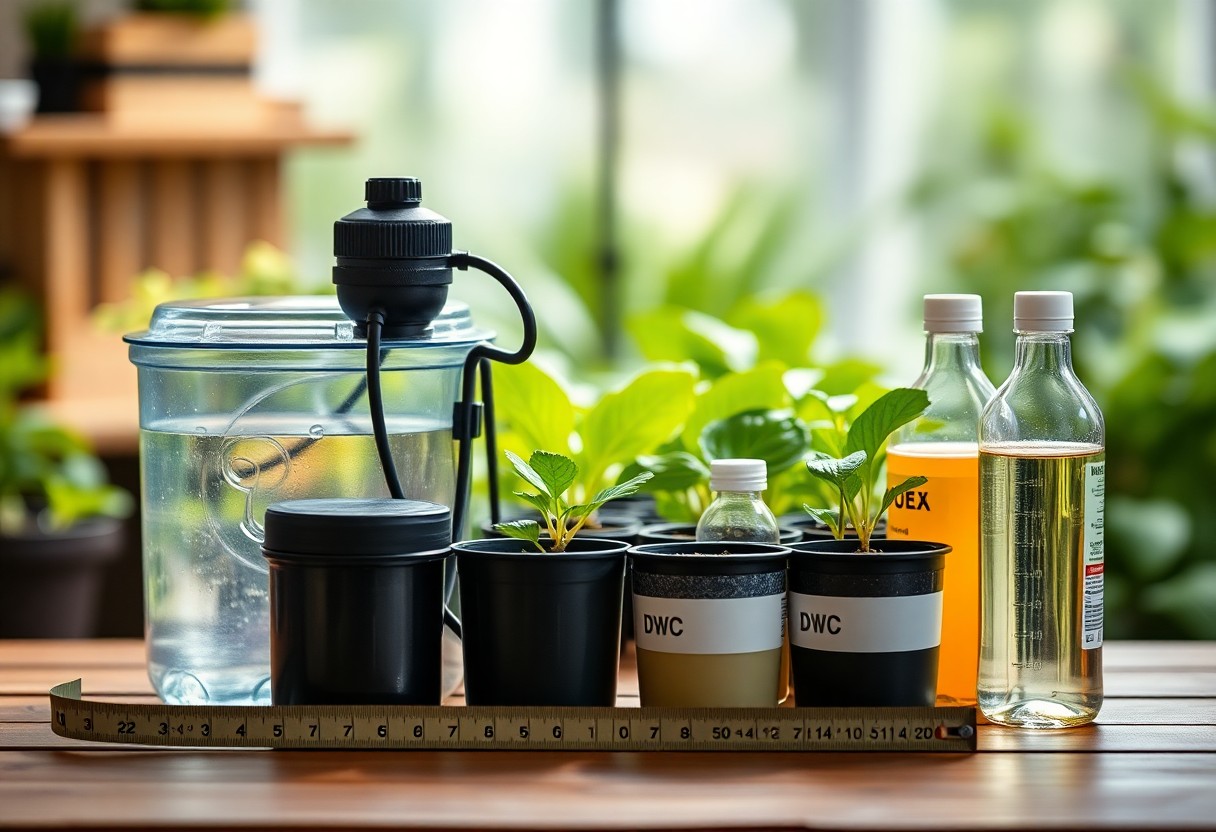
Ensuring Troubleshooting Is Cost-Effective
Common Beginner Mistakes and Their Solutions
New growers often fall into familiar traps that can lead to both wasted resources and dissatisfied plants. Over-fertilizing is a common mistake, driven by the desire for fast growth. A simple remedy is adjusting nutrient concentrations according to the manufacturer’s guidelines and opting for organic solutions that are less harsh on young plants. Another frequent error involves not monitoring pH levels effectively. Investing in a reliable pH meter will help achieve the optimal range for plant absorption, ultimately reducing the chances of nutrient lockout. Lighting issues also plague beginners, especially when artificial sources are used. Many new growers excessively position lights too close to their plants, leading to leaf burn and stunted growth. A rule of thumb is to maintain the recommended distance depending on the specific light type, ensuring plants receive adequate light without being scorched. Identifying these mistakes and applying solutions early can save considerable expenses and emotional stress.Online Resources: Learning from the Community
The powerhouse of knowledge for aspiring growers often stems from online forums and social media platforms where experienced hydroponic enthusiasts share their insights. Communities like Reddit’s r/hydro and various Facebook groups are treasure troves of information—users discuss their successes and failures while providing advice on troubleshooting common problems. By engaging in these communities, newcomers can avoid pitfalls others have faced and adapt techniques that yield impressive results. YouTube is another fantastic resource, with countless channels dedicated to hydroponics. Visual demonstrations of growing techniques, setup guides, and troubleshooting tips can offer immediate, practical insight that written articles may lack. This visual learner-friendly approach helps gardeners grasp complex concepts, stirring motivation and confidence to nurture thriving plants.Alternatives to Professional Advice: Self-Education Options
Self-education plays a pivotal role in mastering hydroponics on a budget. Numerous online courses and downloadable eBooks are available, targeting distinct aspects of hydroponic cultivation. Websites like Udemy and Skillshare offer affordable classes that range from beginner tutorials to advanced methodologies. Participants can learn at their own pace, ensuring they gather knowledge without incurring high costs. The wealth of articles available on dedicated blogs and websites will also enrich a learner’s understanding of hydroponics. By regularly viewing industry news, gardeners can stay updated with the latest techniques and gear innovations, enhancing their hands-on experience without needing to seek professional consultation. Education through self-guidance not only sharpens skills but also cultivates a robust sense of confidence in managing one’s hydroponic garden effectively.Cost vs. Value: Making Smart Purchases
Long-Term Savings vs. Short-Term Costs
Investing in a durable, high-quality hydroponic system tends to bear more fruit in the long run than opting for the least expensive option available. For example, a beginner might find a low-cost reservoir, but over time, cheaper materials could break down, resulting in potential leaks, mold growth, or pump malfunctions. The cost of replacing these items can quickly outpace what one would save on an initial bargain purchase. It’s often advantageous to allocate a little extra budget towards gear that offers durability and a solid warranty, as it usually reflects a better investment. Prioritizing long-term savings doesn’t just cover replacement costs. It also encompasses efficiency in usage and maintenance. When systems are built to last, they often have lesser energy needs, leading to lower operational costs. If one invests a bit more in energy-efficient pumps or LED lights, significant savings can accumulate over time, as well as increased yield from healthier plants.Evaluating Quality: What You Shouldn’t Skimp On
Quality should guide every purchasing decision when entering the DWC realm. Essential gear such as water pumps, air stones, and nutrient solutions can significantly affect success. A cheap pump might become ineffective or even burn out before the planting season is over, thus leading growers to rush out for replacements. This cycle of repeated purchases highlights the necessity for paying attention to reliable brands that have a history of performance. Beyond just functionality, reputable brands also often provide customer support and guarantees that can save time and stress in troubleshooting. They should also avoid cutting corners on items like pH meters and nutrient management tools. Investing in accurate measuring tools ensures that growers can keep a close eye on their plants’ needs. Mismanagement in nutrient levels can lead to issues like nutrient burn or deficiencies that are more costly to remedy than preventing them with the right equipment initially.Where to Look for the Best Deals: Insider Tips
Savvy shoppers often find the best deals online. Websites like Amazon and eBay provide a plethora of reviews that can guide decisions and help find budget-friendly options without compromising on quality. They often have flash sales, seasonal discounts, and promotions that allow even beginner growers to save significantly. Exploring local hydroponic stores can be equally beneficial, especially during sales events or the launch of new products when they might clear out older stock at reduced prices. Additionally, joining online gardening forums and social media groups can yield insider tips about discounted equipment and frequently used brands. Seasoned growers often share their go-to sources and even set up group buys to help reduce shipping costs. Staying connected with such communities keeps growers informed about the latest trends, potential pitfalls in equipment choices, and where to snag the best prices.- Online marketplaces like Amazon and eBay usually have competitive pricing.
- Seasonal sales and promotions at local hydroponic stores can offer valuable discounts.
- Participate in online forums and communities for insider tips and shared experiences.
- This provides a wealth of information about reliable gear and how to find it affordably.
- Utilize community experiences to make informed decisions on hydroponic gear.
- Focusing on quality items will lead to better yields and growth outcomes.
- Patience in waiting for the right price can yield substantial savings on vital equipment.
- This strategy allows growers to build a thriving setup with less financial strain.
Final Words
With this in mind, individuals looking to establish a deep water culture (DWC) hydroponic system on a budget can find everything they need to get started for under $100. They can select vital equipment such as a robust air pump, air stones, net pots, and nutrient solutions, which will work together to create a thriving environment for plant growth. By prioritizing the right tools, they set themselves up for success in cultivating their plants efficiently while keeping expenses in check.
Ultimately, launching a DWC system doesn’t require a significant financial investment. With careful planning and research, he, she, or they can source quality gear that meets their needs without breaking the bank. This approach not only makes it accessible for beginners but also encourages experimentation and learning in the hydroponic gardening journey. As they gain experience, they can always expand their toolkit and cultivate their expertise in hydroponics further.
FAQ
Q: What is DWC and why should I consider it for my gardening needs?
A: DWC, or Deep Water Culture, is a hydroponic method where plants are grown with their roots submerged in a nutrient-rich oxygenated water solution. This system allows for faster plant growth and higher yields compared to traditional soil gardening. If you’re looking to grow plants efficiently and have limited space, DWC can be a great option for you.
Q: What are the necessary items included in a budget-friendly DWC starter kit?
A: A basic DWC starter kit typically includes a reservoir for water, an air pump for oxygenation, air stones to distribute air evenly, net pots to hold the plants, hydroponic nutrient solution, and a growing medium such as clay pebbles. These components work together to provide a sustainable environment for plant growth.
Q: How much should I expect to spend on necessary DWC gear?
A: You can create a basic DWC setup for under $100 by purchasing budget-friendly equipment. The prices of individual items can vary, but with careful selection, it’s entirely possible to gather all necessary components within this budget.
Q: Is it difficult to set up a DWC system on a budget?
A: Setting up a DWC system can be straightforward, even on a budget. Most components are user-friendly, and many products come with easy-to-follow instructions. If you conduct some research and watch tutorial videos, you’ll find that creating a DWC setup is an achievable project for beginners.
Q: Can I use my DWC system for all plants?
A: While many plants thrive in DWC systems, leafy greens, herbs, and small fruiting plants like cherry tomatoes or peppers are particularly well-suited for this method. Larger plants or root vegetables may require more space or different setups. It’s important to choose plants that are appropriate for the DWC environment.
Q: How do I maintain my DWC system for optimal growth?
A: Regular maintenance is key to a successful DWC system. This includes checking and adjusting the pH of the water, monitoring water levels, ensuring the air pump is functioning properly, and regularly updating the nutrient solution as the plants grow. Keeping the system clean and free from algae and debris is also necessary for healthy plant growth.
Q: Where can I buy budget-friendly DWC gear?
A: Budget-friendly DWC gear can be found at local garden supply stores, hydroponics specialty shops, or online retailers like Amazon, eBay, or specialized horticultural websites. Look for deals, bundles, or used equipment to further reduce costs while gathering your necessary gear.

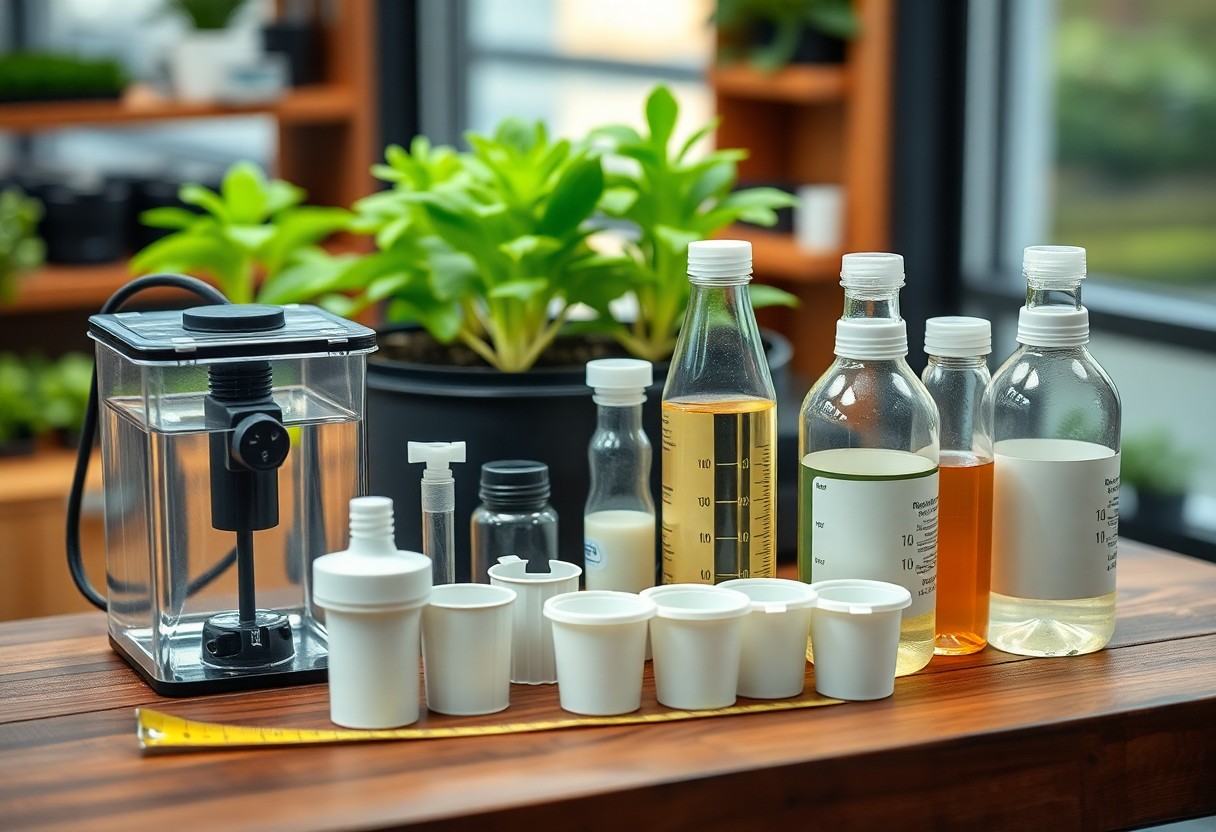
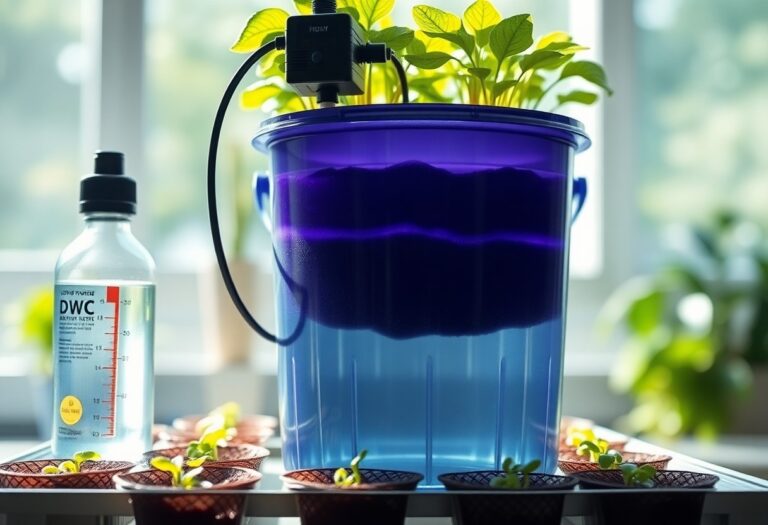
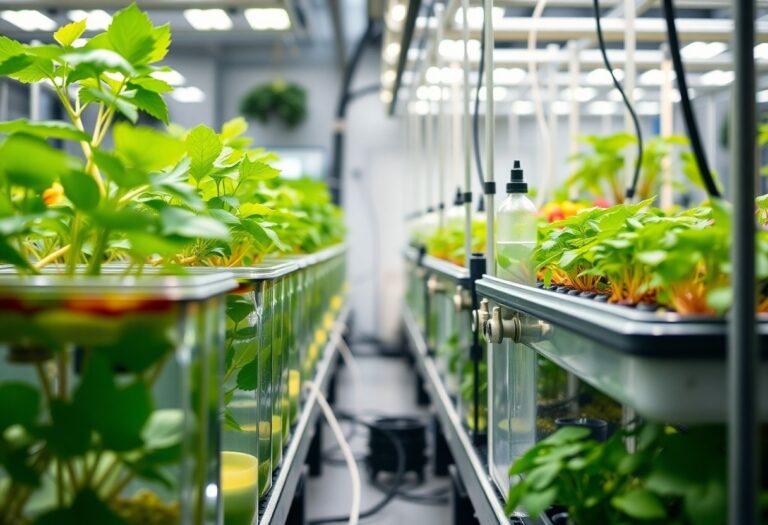

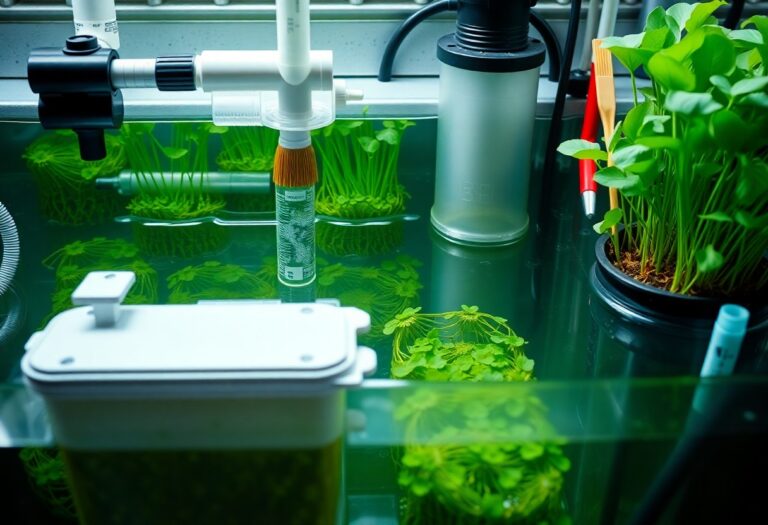
Leave a Comment